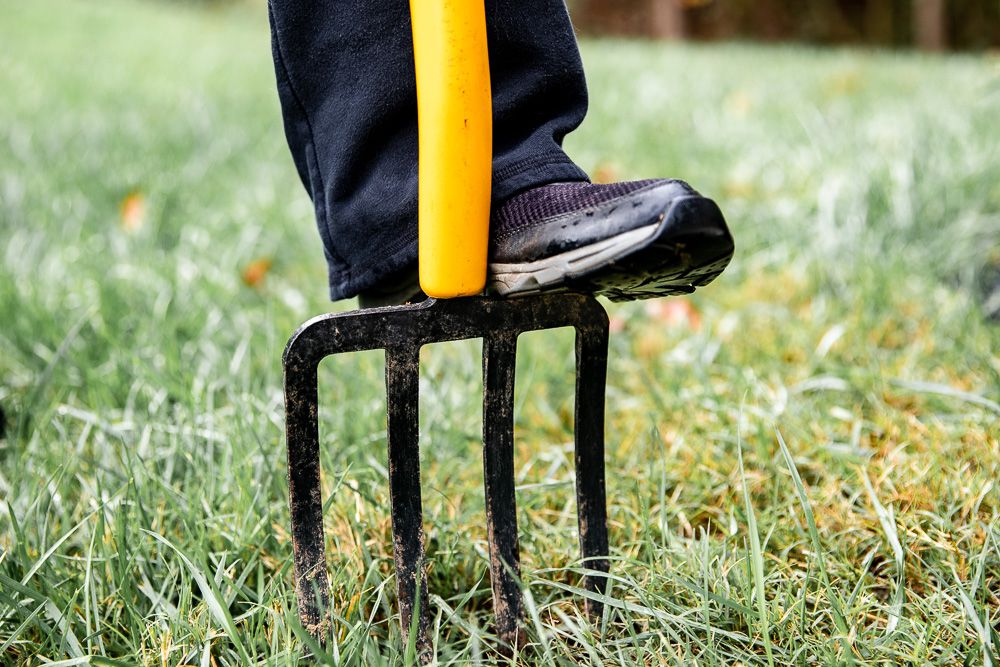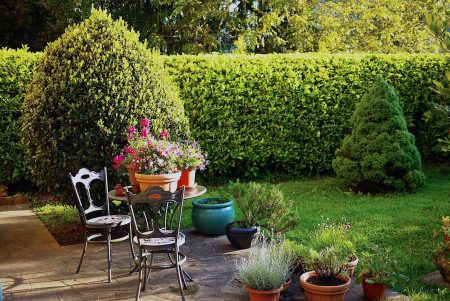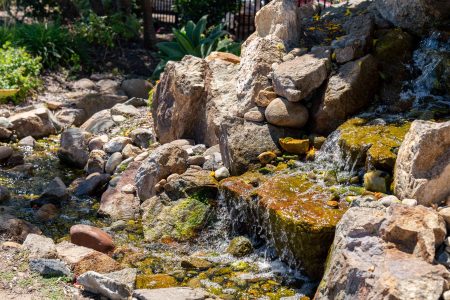The basic idea behind lawn aeration is to help your lawn and the soil under it to breathe. Aerating a lawn is worth the time and effort because it will help it grow better. But how do you accomplish this? And when should you aerate your grass? Read on to learn how to aerate a lawn and why aerating lawn benefits your landscape.
What Is Lawn Aeration?
Lawn aeration simply means making holes, slices, or using other methods to help air, water, and nutrients to penetrate the soil. The process of lawn aeration can be done by hand (or by foot with shoe spikes), with a pitchfork or spading fork (“spiking”), or with more elaborate tools or liquid solutions.
Why Lawns Need Aeration
Lawn aeration reverses the effects of soil compaction. Compacted soil is practically impenetrable, making it difficult for the ground to get air, water, and nutrients. It makes it hard to support vigorous plant growth. Aerification helps compacted soil recover by providing moisture and air penetration. A well-aerated lawn will help the soil support a deeper and healthier root system and stimulate microbes to decompose thatch.
Thatch Buildup
Thatch is the loose, organic layer of dead and living material in the lawn: shoots, stems, and roots that develop between the zone of green vegetation and the soil surface. Thatch buildup begins when turf produces organic debris faster than it can be broken down. Thick lawn thatch buildup makes breathing difficult for your lawn. However, not all thatch is bad. A thin layer of thatch in lawns provides insulation against extreme temperatures and fluctuations in soil moisture. When thatch is more than an inch deep, that can cause problems.
Too much thatch can hold excess water, reducing oxygen reaching turf roots. It can also increase pest problems by harboring disease-causing organisms and insects. Remove as much lawn thatch as you can in the fall by raking deeply rather than just skimming the autumn leaves off the top of the lawn.
Compacted Soil
Lawn aeration breaks up compacted soil, allowing water, air, and nutrients to permeate into the root zone. Grassy areas submitted to constant foot traffic (or, worse, car traffic) require lawn aeration more frequently than out-of-the-way areas.
When to Aerate Your Lawn
Lawn aeration performed in late winter, late spring, or fall helps control lawn thatch. The best time to aerate your lawn should be when the grass is at its peak growing period so it can recover quickly after the process. Here are two rules of thumb:
- Aeration for warm-season grasses, such as Bermudagrass, is best done in the late spring or early summer.
- For lawns planted with cool-season grasses (such as Kentucky bluegrass), February (into the first week of March before spring hits) or fall is the best time for core aeration.
Typically, if you don’t see any issues with your lawn, you can aerate it every two to three years. However, annual aerating may be necessary for high-traffic areas or if your lawn grows in heavy clay soil.
Types of Lawn Aerators
Plug or Core Aerator
Core aeration uses a manual or motorized lawn aerator machine. It has hollow tines that mechanically remove plugs or cores of soil and thatch from a lawn, leaving the cylindrical, pulled cores laying on the turf. This instantly reduces compaction in the soil. Open holes allow air, fertilizers, and water to reach the roots. Core aeration is great for heavy clay soils. A motorized machine is best for more extensive lawns or properties.
Spike Aerator
A spike aerator creates holes in the ground by pushing the soil sideways as wedge-shaped spikes penetrate the soil. But since no soil is removed from the ground, watering can cause compacted soil to close up the temporary holes. Spike aeration is better for sandy or loamy soils.
Slice Aerator
A slice aerator is much like a spike aerator; however, it uses a blade to slice diagonally into the soil. Like a spike aerator, it doesn’t leave cores behind on the lawn, so the yard doesn’t look disturbed or unsightly.
Liquid Aerator
Liquid aeration involves spraying an enzymatic solution on your lawn that breaks down the thatch. This process may need many applications and can take months or years before overcoming the thatch problem. It’s not the preferred method since it’s not an immediate fix for soil compaction; however, its most significant benefit is it’s the easiest to apply.
How to Aerate Your Lawn With a Core Aerator
- Renting an aerator: You can rent a lawn core aerator from a home improvement store or rental center. Since you should not need to aerate your lawn frequently, renting rather than purchasing the aerator may make better financial sense.
- Preparing to aerate: The plug removal process is facilitated by watering the lawn the day before, but don’t water to the point of muddying the soil.
- Using the aerator: This lawn aeration equipment will pull plugs (or cores) of soil from the ground, letting air in. These plugs should be 2 to 3 inches in depth. The plug should be pulled out of the lawn about every 3 inches. Leave the plugs on the grass: they’ll break down and add nutrients to the soil.
- What to do after aerating: Water the lawn every two to three days after aerating. This is also the best time to overseed your lawn, but do it reasonably quickly after aeration, such as within a couple of days.
- When to hire pros: If your thatch problem is severe (about 3/4 of an inch thick or more), rent a vertical mower from a rental center or hire a lawn service to do the lawn aeration job.
Read the full article here









